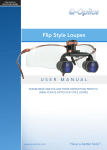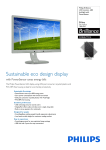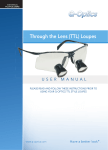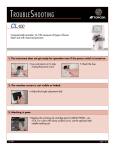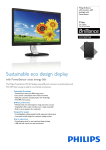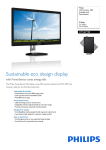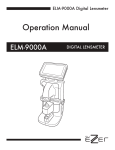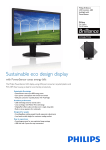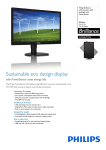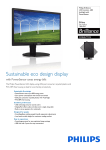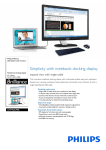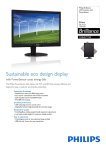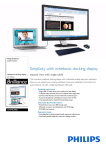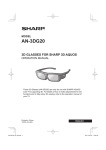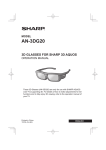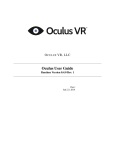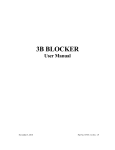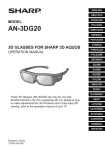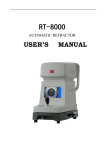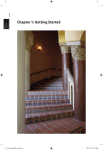Download PDF
Transcript
AUTO LENSMETER USER’S MANUAL MODEL# ALM-411 USER’S MANUAL Table of Contents Warning and Cautions . . . . . . . . . . . . . . . . . . . . 3 Description of Lensmeter . . . . . . . . . . . . . . . . . . . 4 Safety Notes . . . . . . . . . . . . . . . . . . . . . . . . . . . . . . 4 Installation . . . . . . . . . . . . . . . . . . . . . . . . . . . . . . 4 Configuration . . . . . . . . . . . . . . . . . . . . . . . . 5 Parts Identification . . . . . . . . . . . . . . . . . . . . . . . . . . 5 Measurement Display . . . . . . . . . . . . . . . . . . . . . . . . . 6 Menu Display . . . . . . . . . . . . . . . . . . . . . . . . . . . . . 7 Operations Procedures . . . . . . . . . . . . . . . . . . . . 9 Preparation . . . . . . . . . . . . . . . . . . . . . . . . . . . . . . 9 Lens Setting . . . . . . . . . . . . . . . . . . . . . . . . . . . . . . 9 Lens Measurements . . . . . . . . . . . . . . . . . . . . . . . . . 11 Single Vision Lenses . . . . . . . . . . . . . . . . . . . . . . . . . . . . . 11 Mounted Lenses . . . . . . . . . . . . . . . . . . . . . . . . . . . . . . . 11 PD Measurement . . . . . . . . . . . . . . . . . . . . . . . . . . . . . . 12 Contact Lenses . . . . . . . . . . . . . . . . . . . . . . . . . . . . . . . 13 Bifocals/Trifocals . . . . . . . . . . . . . . . . . . . . . . . . . . . . . . . 14 Progressive Power Lenses . . . . . . . . . . . . . . . . . . . . . . . . . . 16 Prismatic Lenses . . . . . . . . . . . . . . . . . . . . . . . . . . . . . . . 18 Marking the Optical Center . . . . . . . . . . . . . . . . . . . . . . . . . . 19 UV Transmittance Measurement . . . . . . . . . . . . . . 20 Specifications . . . . . . . . . . . . . . . . . . . . . . . . 21 Maintenance . . . . . . . . . . . . . . . . . . . . . . . . 22 Replacing Printer Paper . . . . . . . . . . . . . . . . . . . . . . . . 22 Replacing Fuses . . . . . . . . . . . . . . . . . . . . . . . . . . . 22 Cleaning Exterior . . . . . . . . . . . . . . . . . . . . . . . . . . . 22 Accessories . . . . . . . . . . . . . . . . . . . . . . . . . 24 USER’S MANUAL Warnings & Cautions Norwood Device & Diagnostics is not responsible for the safety and reliability of this instrument when: • Assembly, disassembly, repair, or modification is made by unauthorized dealers or persons. • Instrument is not used in accordance with this User’s Guide. WARNING: AN INSTRUCTION THAT DRAWS ATTENTION TO RISK OF INJURY OR DEATH. WARNING: ANY REPAIR OR SERVICE TO THE ALM-411 MUST BE PERFORMED BY EXPERIENCED PERSONNEL OR DEALERS WHO ARE TRAINED BY NORWOOD DEVICE & DIAGNOSTICS SO THAT CORRECT OPERATION OF THE ALM411 IS MAINTAINED. WARNING: THIS INSTRUMENT IS NOT SUITABLE FOR USE IN THE PRESENCE OF FLAMMABLE ANESTHETIC MIXTURES, SUCH AS OXYGEN OR NITROUS OXIDE. CAUTION: AN INSTRUCTION THAT DRAWS ATTENTION TO THE RISK OF DAMAGE TO THE PRODUCT. CAUTION: DO NOT REMOVE THE OUTSIDE COVERS OF THE UNIT OR ATTEMPT TO REPAIR ANY INTERNAL PARTS. REPAIR AND SERVICE OF THE UNIT MUST BE PERFORMED BY EXPERIENCED PERSONNEL OR DEALERS WHICH ARE TRAINED BY NORWOOD DEVICE AND DIAGNOSTICS. CAUTION: MAKE SURE THAT THE VOLTAGE APPLIED TO THE UNIT IS THE SAME AS THE VOLTAGE WHICH IS GIVEN ON THE DATA PLATE NEXT TO THE INPUT CORD RECEPTACLE OR DAMAGE TO THE UNIT MAY OCCUR. CAUTION: DO NOT USE SOLVENTS OR STRONG CLEANING SOLUTIONS ON ANY PART OF THIS INSTRUMENT AS DAMAGE TO THE UNIT MAY OCCUR. SEE MAINTENANCE SECTION FOR DETAILED CLEANING INSTRUCTION. CAUTION: USE OF ALCOHOL ON THE LIQUID CRYSTAL DISPLAY (LCD) MAY CAUSE DAMAGE TO DISPLAY. SEE MAINTENANCE SECTION FOR DETAILED CLEANING INSTRUCTION. CAUTION: THIS INSTRUMENT IS NOT SUITABLE FOR USE IN THE PRESENCE OF FLAMMABLE ANESTHETIC MIXTURES SUCH AS OXYGEN OR NITROUS OXIDE. CAUTION: THIS INSTRUMENT HAS ELECTROSTATIC DISCHARGE SENSITIVE DEVICES (ESDS) WHICH ARE SENSITIVE TO STATIC HIGH VOLTAGES STORED IN AND TRANSFERRED BY THE HUMAN BODY. OBSERVE CORRECT ESDS PRECAUTIONS OR PREMATURE MALFUNCTION OF THIS INSTRUMENT WILL OCCUR. CAUTION: THIS INSTRUMENT MUST BE PLUGGED INTO AN OUTLET WITH AN EARTH GROUND WHICH IS CONNECTED TO THE RECEPTACLE OR DAMAGE TO THE UNIT MAY OCCUR. DO NOT DISABLE OR REMOVE THE GROUND PIN. CAUTION: THE POWER CORD IS THE DISCONNECTING DEVICE FROM THE ELECTRICAL POWER SOURCE. DO NOT POSITION THE INSTRUMENT SO THAT IT IS DIFFICULT TO OPERATE OR DISCONNECT THE POWER CORD FROM THE POWER SOURCE. 3 3 USER’S MANUAL Description of the Lensmeter Description This Auto Lensmeter is used for measuring single vision lenses, bifocal (trifocal) lenses, progressive power lenses (PPL), and contact lenses (CL). The display screen utilizes a full-graphic LCD, displaying measured values of right-eye and left-eye lenses at one time and graphically showing the alignment condition in the shape of a target. The menu is simple and clear. Icons are conveniently located on the screen with touch screen built-in UV tester. Safety Notes • Be careful when you carry the instrument, strong shock may damage the unit. • Make sure to place the instrument on a level and stable place. • Avoid using the instrument in a place that is exposed to direct sunlight or near incandescent light. • Do not use the instrument in the following environment: Below Temperature: 41°f | Above Humidity: 80% • Clear the instrument regularly in order to make the measurement work accurately. After use, turn off the power and cover with dust cover. • Be sure that the nose slider is on the left of the instrument. • If you hear any abnormal sounds coming from the unit, turn off the unit and contact distributor. Installation • Check to be sure that all accessories are included in packaging. • Connect power cord to the power inlet at the back of the instrument and then at the wall outlet. 4 USER’S MANUAL Configuration Parts Identification • Read Button: Button for reading data. This makes the measured data on the display fixed so it will be saved in memory. • Protective cap: Used as a dust cover, remove before measuring and replace when done. • Nosepiece: Used to place the lens on the base point for measurement. When measuring contact lenses (CL), replace this with the special CL nosepiece. • Lens Holder Lever: Used to move the lens holder. To fix the lens, lift once and lower it gently. To remove the lens, lift it until it clicks. • Nose Slider: Used to measure PD of spectacles. When the nose pads of the spectacles are placed astride, it automatically detects the lens sides and calculates the distance between the right and left ‘read’ positions as the PD value. • Pilot Lamp: Power ON when lit. • Marking Lever: Used for marking lenses. Put spectacles in place then lower the lever to mark lenses. • Lens Table Lever: Used to move the lens table back and forth. • Printer: Used to print measured data. • UV cover: UV measuring part cover. • NOTE: The display will automatically turn OFF when not in use for a period of time. The auto OFF time limit can be changed in the MENU DISPLAY. To turn unit back ON, press any button. 5 5 USER’S MANUAL Configuration Measurement Display Setting Signs 0.01, 0.12, 0.25 Steps +/-, +,- CYL reading direction 30.40.50.60 Abbe value Target Shows the measuring point while lens is on the nosepiece. The shape of the target changes with alignment. O Out of center + In the center within 0.5 + Aligned to the center (marking point) R/L sign Appears when the lens side is specified, and values below each show the measured data of the side. “S” sign Shows that the measured lens is single. PD values Show both monocular PD (LPD,RPD) and total PD of spectacles. 6 USER’S MANUAL Configuration Menu Display 7 7 USER’S MANUAL Configuration Menu Display (continued) 8 USER’S MANUAL Operations Procedures Preparation • Connect the power cord to the power inlet. • Connect the power cord to the wall outlet. • Turn on the power. • NOTE: • Do not turn on the power with the lens on the nosepiece. If the lens is on the nosepiece, a ’DATA ERROR’ message will appear on the measurement display. Remove the lens and turn on the power again. • The same will happen if the protective cap is on nosepiece, take it away and try again. • Check if the nose slider is on the left end. If not, a ‘PD ERROR’ appears. Lens Setting Specify the lens side • When you don’t need to measure PD values, make sure the nose slider is flipped to the left. Press L\R button to specify right-eye or left-eye lens. • When measuring PD, the position of the nose slider will be taken for the R\L judgment and R\L button reoperation will be ignored. It can measure LPD, RPD or the distance between the optical centers. Continued on page 10 » 9 9 USER’S MANUAL Operations Procedures Lens Setting (continued) Set the lens • Place the measuring lens on the nosepiece with the convex side up Fix the lens • Place the measuring lens on the nosepiece with the convex side up. 10 USER’S MANUAL Operations Procedures Lens Measurement Measuring Single Vision Lenses • Bring the target to the center. Move the lens to bring the target ‘O’ close to the center of the alignment circle. • When the target comes within a range of 0.5 ∆ from the center, the shape of the target changes to a cross line. Moving the lens to align the target, the shape of the target changes to a large cross. There are two ways to measure. • Pressing the read button, the measured data will be fixed. Pressing +/- alternates the cylinder reading direction. Pressing the clear button, the measurement will repeat again. • When the ‘AUTO READ’ parameter is set, data will be automatically fixed after the target is centered. Just as the read button is pressed to repeat the measurement, press the ‘Clear’ button first, perform alignment and press the ‘Read’ button again. Measuring Mounted Lenses REGULAR MEASUREMENT • Press ‘L/R’ button, bring the target to the center. Move the lens to the target ‘O’ close to the center of the alignment circle. When the target comes within a range of 0.5 ∆ from the center, the shape of the target changes to a cross line, move the lens to align the target ‘O’ to the center cross so that the shape of the target changes from a cross line to a large cross. Press the read button and the measured data will be fixed. • Press L/R button, measure the other lens, and repeat the same steps as the first lens. 11 11 USER’S MANUAL Operations Procedures Lens Measurement PD Measurement Alternate L/R lens by moving nose slider. • Move the lens table until it touches the button of the frame and move nose slider to the center of mounted lenses. • Move the lens to bring the target close to the center of the alignment circle. When the target comes within a range of 0.5 ∆ from the center, the shape of the target changes to a cross line. • Move the lens to align the target to the center cross, so that the shape of the target changes from a cross line to a large cross. • Pressing the ‘read’ button, the measured data will be fixed. • Measuring the other lens, repeat the same steps as the first lens. • Press Print Button to Get Value. 12 USER’S MANUAL Operations Procedures Lens Measurement Measuring Contact Lenses 1. Change the nosepiece to the CL nosepiece for contact lens. 2. Establish the CL measurement mode as shown. 3. Set the CL. 4. Align the target. • Place the lens on the nosepiece with the convex side up. NOTE: Hold the CL with tweezers. Be careful not to damage the lens, only use tweezers with round tips. 5. Press the ‘read’ button. 6. Press the ‘mode’ button, the mode returns to the normal measurement mode. NOTE: • Measure the contact lens as quickly as possible so that the lens surface does not become dry. 13 13 USER’S MANUAL Operations Procedures Lens Measurement Measuring Bifocals or Trifocals 1. Bring the distance part onto the nosepiece. 2. Measuring the distance power. • After the shape changes from a circle to a cross line, press the ‘read’ button. The measured data distance will be fixed. 3. Measuring the addition power (ADD) • Pulling the lens toward you to bring near portion onto the nosepiece, press the ‘add’ button. • The ADI appears on the display, when the shape changes from a circle to a cross line, press the ‘read’ button. • The measured data for near portion will be fixed. • For bifocals, the measurement is completed at this point. • For trifocals, go to the next step on next page. 14 USER’S MANUAL Operations Procedures (continued) Lens Measurement (trifocals continued) 1. Bring the near portion onto the nosepiece. • Press ‘add’ button. AD2 appears on the display. • After the shape changes from a circle to a cross line, press the ‘read’ button. • The measured data for near portion will be fixed 15 15 USER’S MANUAL Operations Procedures Lens Measurement Measuring Progressive Power Lenses (PPL) • Pressing Mode change button, the PPL measurement mode will be established. Measuring uncut lenses. • Using the manufacturer’s specific eye point marks, the lens should be placed with its horizontal marks paralleled to the table. The near position is inside. ADD and the measured data appear in the display. Bring the distance part onto the nosepiece, then move the lens slowly. Measuring mounted lenses • Set the lens. • Bring the distance part onto the upper third of lens. • Bring the target to the guideline. Move the lens sideways to bring the target into the middle of the guideline. When the target changes to a cross (+) or +, press ‘read’ button, the distance is fixed. 16 USER’S MANUAL Operations Procedures Lens Measurement • Use manual or automatic memory for measuring distance. • When the ‘Push’ sign appears, move the lens according to arrow direction. It will start to measure the progressive region. Meanwhile, the screen demonstrates the ADD hestogram. • Search for the point where the ADD degree changes, when it is at maximum value, press the ‘memory’ button and finish the measurement. NOTE: When gradually moving lens, uncut lens’, nearsighted ,partial edge, or farsighted partial edge, some lens prisms may be too big, surpassing the instrumental measuring scope. If this happens the instrument will demonstrate ‘over prism’. Move the lens toward the middle. The ADD of some lenses consequently increases, sometimes out of the range of near portion. If this happens, the biggest ADD is the range of near portion. Press the ‘read’ button when the icon appears in the near portion. 17 17 USER’S MANUAL Operations Procedures Lens Measurement Measuring Mounted Prismatic Lenses • To mark the pupil center, instruct the customer to wear the spectacles and look straight. Then mark the pupil center on each lens. NOTE: The mark should be smaller than 1mm in diameter. Anything bigger may interfere with the measurement. • Specify the lens side. Press L/R button to specify right eye lens or left eye lens. • Choose the prism indication type • Rectangular coordinates ∆ : I 5.00 D0.03 • Polar coordinates ∆ : 1.00° • Set the lens by placing the lens on the nosepiece as shown with the convex side up. • Fix the lens with the lens holder. • Bring one of the eye point marks to the center of nosepiece. • Press the ‘read’ button. 18 USER’S MANUAL Operations Procedures Lens Measurement: Step 3 (continued) Marking the Optical Center This is the method used to mark the lens in order to specify the optical center and the horizontal direction for mounting it to a frame. • Move the lens more to align the target to the center cross so that the shape of the target changes from a cross line to a large cross. • Set the axis to the prescribed value. While watching the axis value on the display, rotate the lens until the value shows the prescription. If the large cross changes back to a cross line, align again. • Set the prismatic lens to the prescribed value, press the ‘menu’ button and make the prismatic value the same as the prescribed prism value. • Choose rectangular coordinates. ’O’ means base out, ‘I’ means base in, ’D’ means base down and ‘U’ means base up. • Put the measuring lens onto lens table, rotate it gently and make the direction the same as the prescribed value. • Press the marking lever down to mark the lens. Three points in a line parallel to the lens table will be marked. • To remove the lens, raise the lens holder lever until it clicks. NOTE: • Do not touch the markings as the ink is easy to smear. 19 19 USER’S MANUAL UV Transmittance Measurement Measurement Process • Turn on power. • Take out the UV measuring part cover. • Press UV button. • Set the lens on the place of the UV measuring part. • The measurement appears in the screen. NOTE: • When no lens in place, UV transmittance rate is 100%. • If not, wipe the two windows of measuring box with a dry cloth. • Do not place the lens inside the measuring part before pressing UV button. • It will automatically close after two minutes when you do not use the UV measurement after pressing UV button. • In order to protect and save the life of UV measuring part, please close this function after measuring lens. 20 USER’S MANUAL Specifications ALM-411 Specs Measure Scope Sphere 0~±25D(0.01/0.12/0.25D steps) Cylinder 0~±9.99D(0.01/0.12/0.25D steps) Axis 0~180(1° step) Addition 0~±9.99D(0.01/0.12/0.25D steps) Prism 0~15 (0.01/0.12∆/0.25∆ steps) Measurement Mode Measuring Mode Lens Auto Recognition Contact Lens Pupil Distance 45~90mm, 0.25mm steps Cylinder +, -, +/- Prism X-Y, P-B Measuring Speed 0.1 second Lens Diameter ¢ 20~108mm Contact Lens Soft/Hard Lens Display 5.6" LCD/TFT Print Thermal Printer Power Supply 100~240V 50/60HZ 25W Dimension 222*161*372mm3 Package 530*330*370mm Weight Approx. 6KG 21 21 USER’S MANUAL Maintenance Replacing Printer Paper 1. The cover opens by pressing the ‘O’ mark on the top of the cover. 2. Hold up the green control stick. 3. Make sure the paper is not jammed, but cut cleanly. 4. Set the new printer paper, if needed. 5. Pass the printer paper through the paper outlet of the printer cover head, down the green control stick, and close the cover. Replacing Fuses If the instrument does not turn on, the fuse may have blown. Replace them with the spare fuses provided. 1. Turn off the power. 2. Disconnect the power cord from the wall outlet. 3. Remove the fuse holder. 4. Replace the fuses. 5. Set the fuse holder back into position. Cleaning Exterior • When the exterior parts of the instrument become dirty, wipe with a soft, dry cloth. • For stubborn dirt, immerse the cloth in a neutral detergent, wring well and wipe. • Finally, wipe off with a soft, dry cloth. CAUTION: • Never use an organic solvent such as paint thinner to clean the instrument as it may ruin the surface of the instrument. 22 USER’S MANUAL Maintenance Cleaning protective glass • For optimal product performance, clean dust and dirt from the protective glass underneath the nosepiece on a regular basis. • Lift up to remove the nosepiece and clean the protective glass. • Blow off any dust on the glass with a blower brush. • If it is still dirty, wipe gently with a lens cleaning paper. Ink Refilling When markings become faint, please refill the ink box. NOTE: • Do not drop to other spots, if so, please use a cotton ball dipped in alcohol to clean. 23 23 Accessories Contents of ALM-411 1. Printer paper 6. Nose-piece 2. Spare fuses 7. Nose-piece (for contact lens) 3. Dust cover 8. User’s manual 4. Glasses cloth 9. Ink 10. Power cord 5. Protective cap 11. PC Cable (1) (5) (2) (3) (6) (4) (7) (8) (9) ( 10 ) ( 11 ) DISTRIBUTED BY: NORWOOD Device & Diagnostics 1 North Morton Ave. 2nd Floor Morton, PA 19070 WWW.NORWOODVISION.COM | 855.370.1900

























